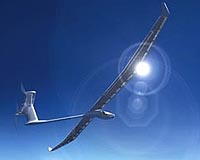 |
Berlin (UPI) Jun 26, 2009 As the world's reserves of hydrocarbon fuels dwindle, a German-led consortium is pushing ahead with a revolutionary plan to build a giant thermal solar power plan in the North African desert that would provide up to 15 percent of Europe's electricity needs. The ambitious project, known as Desertec, is expected to cost $555.3 billion. It would generate inexhaustible and affordable quantities of energy across the Mediterranean -- and even on a global scale if necessary. One of its big attractions is that it would emit no carbon dioxide in the process. If Desertec ever gets off the ground it would be the largest green-energy project on the planet. In theory, a global system of solar thermal power would also eliminate the prospect of resources wars erupting in the years ahead as the planet's natural resources that currently produce energy -- oil, gas and coal -- disappear. The plan, which has been kicking around for years, got a big boost on June 17 when a group of 20 companies, including Siemens, Deutsche Bank, European energy giant E.On and insurance major Munich Re, announced they will launch the initiative at a meeting on July 13 and consolidate the consortium. Munich Re Director Torsten Jeworrek said the consortium aims to "present concrete plans in two or three years" and start producing commercial quantities of power within a decade, freeing energy-hungry Europe from its dependence on oil, natural gas and coal. The idea for this massive project to harness the sun's energy on a grand scale originated with a group of European scientists and politicians called the Trans-Mediterranean Renewable Energy Cooperation. The concept of large-scale solar power has been around for some time but was never able to make the breakthrough because of cheap oil. Those days disappeared, probably forever, a few years ago when the price oil soared to nearly $150 a barrel. In recent months it plunged back to $40 and his since crept back up to around $70. But that is still double the level it was only five or six years ago. "No energy source even comes close to achieving the same massive energy density as sunshine," observed Hans Muller-Steinhagen, who has been commissioned by Germany's Environment Ministry to investigate the feasibility of Desertec. He thinks it's a "real possibility." The technology is already available, according to Muller-Steinhagen. Solar power plants have been operating, without problems, in California and Nevada since the mid-1980s. Solar plants are now being built in southern Spain, and construction has started on similar plants, on a scale infinitely smaller than that envisioned for Desertec, in Algeria, Morocco and the United Arab Emirates. Desertec, according to its advocates, will be distinctly low-tech and won't require nuclear reactors or CO2-emitting coal-fired power plants. The sun's energy would be collected in huge arrays of curved mirrors known as "parabolic trough collectors." They would heat water, which generates steam that drives turbines that produce electricity. Muller-Steinhagen estimates that a huge complex of these mirrors across an area the size of Austria in the vast empty desert could produce enough energy to meet the entire global demand. An area one-quarter that size would be enough to power all of Europe. Every year the sun produces 630,000 terawatt hours of energy in the Maghreb, the Arabic name for North Africa, that is untapped. Europe consumes just 4,000 terawatt hours of energy a year. That's only 0.6 percent of the unused energy that falls on the North African desert. Solar energy can also be harnessed even in the hours of darkness, experts say. Heat produced during the day can be stored in tanks of molten salt, allowing the Desertec turbines to produce electricity even when the sun's not shining. For the North African states -- Libya, Morocco, Tunisia, Algeria and Egypt -- Desertec would be of immense economic benefit. It would not only produce cheap energy for the region but create jobs and industrial opportunities that would attract investment. Share This Article With Planet Earth
Related Links All About Solar Energy at SolarDaily.com
 Swiss team unveil pioneering solar plane
Swiss team unveil pioneering solar planeGeneva (AFP) June 26, 2009 Round-the-world balloooning pioneer Bertrand Piccard unveiled his solar-powered aircraft in Switzerland on Friday, ready for another trend-setting circumnavigation of the globe powered solely by the sun. The wasp-shaped prototype of Solar Impulse, with the wingspan of a jumbo jet, was rolled out before some 800 guests at an airfield near Zurich after six years of development. Ten years ... read more |
|
| The content herein, unless otherwise known to be public domain, are Copyright 1995-2009 - SpaceDaily. AFP and UPI Wire Stories are copyright Agence France-Presse and United Press International. ESA Portal Reports are copyright European Space Agency. All NASA sourced material is public domain. Additional copyrights may apply in whole or part to other bona fide parties. Advertising does not imply endorsement,agreement or approval of any opinions, statements or information provided by SpaceDaily on any Web page published or hosted by SpaceDaily. Privacy Statement |